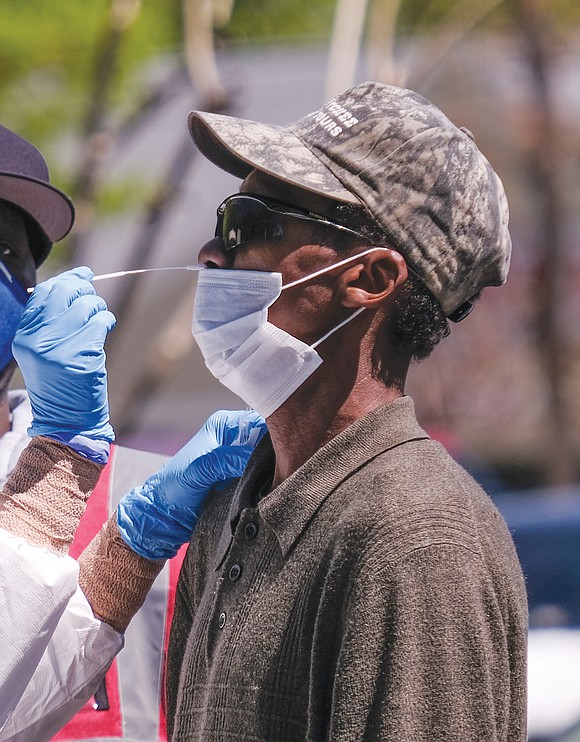Covid-19 cases going unreported
George Copeland Jr. | 6/2/2022, 6 p.m.
Amid a rise in COVID-19 cases and deaths in Virginia and nationally, a gap in reported positive cases has continued throughout Virginia, one that has persisted as the approach to monitoring the worst of the virus and testing for infection has changed and expanded, locally and statewide.
According to Catherine Long, public information officer for the Richmond and Henrico Health Districts, local health officials do believe the current count of positive cases locally and statewide may be an undercount for a number of reasons.
Positive cases are typically detected through tests at local pharmacies, doctor’s offices or local health district events, which are then reported to the Virginia Department of Health. As a result, positive tests outside certain home tests aren’t counted among total numbers reported, unless those using them report positive cases on their own terms. VDH officials noted other possible causes for unreported cases. “Disease surveillance is not intended to capture every case at this point in the pandemic,” the VDH said in a statement. “Due to people being asymptomatic, not testing at all or using at-home test kits of which the results are not reported to the health department, we have no way of knowing how many persons would have positive lab results that are never reported to the health department.”
The milder symptoms of the dominant Omicron strain of COVID-19 may also be responsible for a gap in cases reported, said Ms. Long, as those infected may only register a reaction to infection that could be mistaken for a cold or the flu.
It’s not clear what percentage of positive cases in Virginia may be unreported or currently undetected, as no estimates or projected figures are available. This lack of data makes it difficult to determine how many unreported infections aren’t accounted for as daily case counts have increased in recent weeks.
A total of 2,970 daily cases were reported Wednesday in Virginia, while the percent positivity rate had increased to 18.1 percent at the time.
While the potential for a rise in unreported cases has been expected by health officials, they say that it hasn’t had much impact on their current monitoring efforts, as health groups are now using other ways to track serious infections.
With vaccines more freely available to the public, health agencies have shifted to monitoring hospitalizations, deaths and outbreaks to gauge the impact of COVID-19 in communities, with particular a focus on patients in intensive care and on ventilators to better track the severity of infection.
This move followed a change in the Center for Disease Control’s mask guidance from measuring and ranking community transmission levels for localities to a combination of cases, hospitalization rate and hospital capacity in a given area. This change in monitoring also reflects a greater focus on severe symptoms and deaths over mild cases that can potentially lead to less impact on the infected.
“We’re defining the success of mitigation efforts through reduction in hospitalizations and reduction in deaths and not necessarily reduction in cases,” Ms. Long said. “Because of the challenges in case counts, hospitalizations are a metric that’s much easier to record.”
This approach is not flawless, however, as even mild cases can lead to long-term health complications that change the lives of the infected, but may not always lead to hospital care, particularly for those who can’t afford it.
On the state level, wastewater testing is being used as a new way to better track community spread, as the VDH and several Virginia communities are working as part of a national wastewater surveillance program with the CDC. VDH is currently working on new guidance for its public health partners when it comes to the COVID-19 data found from wastewater testing, which will include what actions to take when spikes or increasing infection trends appear in samples.
This method of infection monitoring would not only allow health systems to detect COVID-19 infections in their early stages, but could offset some of the gaps in reported cases due to any number of factors and “fill the gap during limited testing or reporting,” officials said.
“If cases are unreported, wastewater surveillance may still have them reflected in the viral load,” VDH officials noted. “We cannot identify the exact number of people contributing but can observe an increase in viral load in that particular area if the catchment area is under surveillance.”
COVID-19 testing events, however, are still a recommended option to maintain some measure of accuracy when it comes to case reports in Virginia, and a foundational part of COVID-19 monitoring strategies. Mitigation measures also remain a valuable tool in slowing potential spread.
Those who use home tests or who may be infected but not able to get tested are encouraged to alert the public anonymously through the COVIDWise App.







